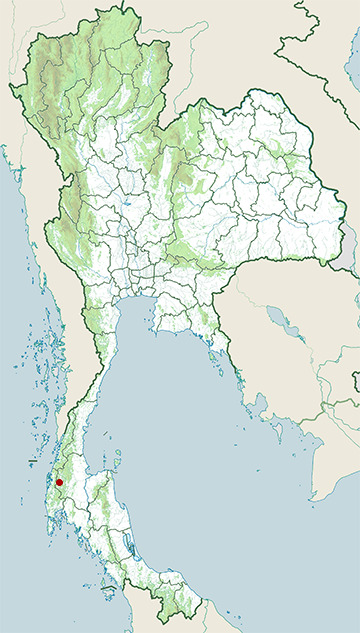Species of Thailand
Wall-roosting mouse-eared bat
Myotis muricola
John Edward Gray, 1846
The wall-roosting mouse-eared bat, or Nepalese whiskered myotis (Myotis muricola) is a species of vesper bat whose type locality is Nepal.
Taxonomic notes
M. muricola was previously classified as a subspecies of Myotis mystacinus but genetic studies indicate that M. muricola represents a complex of species.
Morphology
The upper side of M.muricola is coloured brown or grey with dark bases and the underside has dark bases and light brown tips. The ears are moderately long, slender, bent forwards and bluntly pointed (Francis, 2008). M.muricola has small feet with wing membranes attached at the base of the toes. The tail is long and completely enclosed in the interfemoral membrane. It has three pairs of premolars, with the upper canine much longer than the third premolar. The second premolar is small and slightly intruded from the tooth row (Yasuma, Andau, Apin, Tuh Yit Yu, & Kimsui, 2003).
Distributions
M.muricola is found in Afghanistan, Bangladesh, Bhutan, Cambodia, India, Indonesia, Laos, Malaysia, Myanmar, Nepal, Pakistan, Papua New Guinea, the Philippines, Thailand, and Vietnam (Simmons, 2005).
Ecology
M.muricola is a nocturnal and insectivorous bat. It tends to feed during the first two hours after sunset and before dawn, using ultrasonic echolocation (Richardson, 1993). It catches insects in flight or perched on foliage, the ground or a water surface. Small insects are usually caught directly in the mouth, while larger ones are scooped out of the air using the tail membrane and flipped into the mouth, or brought to the mouth with the wing tips (Bonaccooso, 1998). It drinks by swooping low over the surface of a body of water or collecting droplets of water from the roof of tunnels or caves in which it roosts (Richardson, 1993).
Habitat
M.muricola roosts in a variety of different sites, including curled-up banana leaves (Francis, 2008), limestone forests (Abdullah, Azlan, & Neuchlos, 2005), hollow trees, rock shelters, artificial caves, mines and tunnels, and old buildings (Richardson, 1993).
Conservation status
According to the 2008 IUCN Red List of Threatened Species, M.muricola is classified as Least Concern.
This article uses material from Wikipedia released under the Creative Commons Attribution-Share-Alike Licence 3.0. Eventual photos shown in this page may or may not be from Wikipedia, please see the license details for photos in photo by-lines.
Scientific classification
- Kingdom
- Animalia
- Phylum
- Chordata
- Class
- Mammalia
- Order
- Chiroptera
- Family
- Vespertilionidae
- Genus
- Myotis
- Species
- Myotis muricola
Common names
- English:
- Nepalese whiskered bat
- Whiskered bat
- Nepalese whiskered myotis
- Whiskered myotis
Synonyms
- Vespertilio blanfordi, George Edward Dobson (1871)
- Vespertilio caliginosus, Robert Fisher Tomes (1859)
- Myotis mystacinus, Robert Fisher Tomes (1859)
- Vespertilio muricola, John Edward Gray (1846)
- Myotis mystacinus, John Edward Gray (1846)
- Vespertilio muricola, Brian Houghton Hodgson (1841)
Conservation status

Least Concern (IUCN3.1)
Photos

Range Map

- Khao Sok National Park